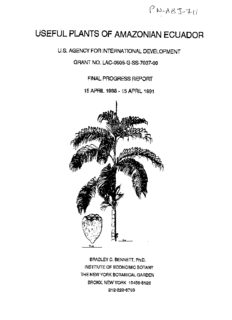
useful plants of amazonian ecuador PDF
Preview useful plants of amazonian ecuador
USEFUL PLANTS OF AMAZONIAN ECUADOR U.S. AGENCY FOR INTERNATIONAL DEVELOPMENT GRANT NO. LAC-0605-G-SS-7037-00 FINAL PROGRESS REPORT 15 APRIL 1988 - '15 APRIL 1991 BRADLEY C. BENNETT, Ph.D. INSTITUTE OF ECONOMIC BOTANY THE NEW YORK BOTANICAL GARDEN BRONX, NEW YORK 10458-5126 212-220-8763 USEFUL PLANTS OF AMAZONIAN ECUADOR U.S. AGENCY FOR INTERNATIONAL DEVELOPMENT GRANT NO. LAC-0605-G-SS-7037-00 FINAL PROGRESS REPORT 15 APRIL 1988 - 15 APRIL 1991 BRADLEY C. BENNETT, Ph.D. INST!TUTE OF ECONOMIC BOTANY THE NEW YORK BOTANICAL GARDEN BRONX, NEWYORK 10458-5126 212-220-8763 FIGURE 1. Agatha Antich and Juan Cristobal Antuash discussing useful Shuar plants in the Shuar Centro Yukutais. ilk I A ................ .......... 7v MCO MA ,VA Ml Al Az. 14U -.......... ,137.lma a k a ......... .... Amp- W? NI - ii - TABLE OF CONTENTS INTRODUCTION 1.............................................1 RESULTS PLANT COLLECTIONS ...... .......................... 4 SPECIMEN PROCESSING ................................ 4 PLANT IDENTIFICATION ............................... 8 ECONOMIC ASSESSMENT ............................... 10 COLLECTION OF LIVING MATERIAL ..................... 13 BOTANICAL TRAINING ................................ 13 DATABASE PREPARATION .............................. 15 INSTITUTION BUILD2NG .............................. 15 OTHER USEFUL PLANT MANUAL ......................... 18 PRESENTATIONS ............................... 29 PUBLICATIONS ................................ 30 SUMMARY ................................................. 33 APPENDIX A .............................................. 36 - iii - LIST OF FIGURES FIGURE 1 ................................................. i FIGURE 2 ................................................ iv FIGURE 3 3.................................................3 FIGURE 4 5.................................................5 FIGURE 5. ................................................. 7 FIGURE 6 ... ............................................. 14 FIGURE 7 ................................................ 22 FIGURE 8 ................................................ 32 FIGURE 9 ................................................ 35 LIST OF TABLES TABLE I.........................................o . .... . 9 TABLE 2 i0..............................................10 TABLE 3 ............................................... . 16 TABLE 4 ................................................ 19 - iv - Figure 2. Fibers obtained from tAe roots of an epiphytic Cyclanthaceae used by Quijos Quichuas to make baskets. NI ob Y7 '41 Al Ov qq lvke eve, 1v vr IN, ft Tt INTRODUCTION In this report, we summarize the New York Botanical Garden's "Useful plants of Amazonian Ecuador Project." This project, which began in April 1988, is supported by U.S. Agency for International Development Grant No. LAC-0605-G SS-7037-00. USAID granted a one-year, no-cost extending the grant's termination until 15 April 1991. Though -nly the size of Alabama, Amazonian Ecuador supports a diverse biota and a diverse indigenous population. For hundreds or perhaps thousands of years, humans have lived in Ecuador's lowland forests. Anthropologists commonly think of the tropical rainforest's effects in shaping culture. No doubt this is true, but lowland inhabitants have also shaped the forest. Through non-random harvesting, protection of useful species, artificial selection and manipulation of animal pollinators and dispersers humans change the species composition of forests. Our desire was to study the plants used by some Ecuador's lowland people and to examine the influence of humans on native vegetation. Acculturation is proceeding rapidly in Ecuador. Of the seven indigenous groups in Amazonian Ecuador, all but one are largely acculturated. Within one generation we will lose most ethnobotanical knowledge. Because of the urgency of the problem, we chose to work with the two largest groups in Amazonian Ecuador: The Quichua and the Shuar. Lowland FINAL PROJECT REPORT - 2 Quichua, descendants of sierra Quichuas and now-extinct lowland cultures, number about 60,000. The Shuar, previously known by the pejorative Jivaro, number about 40,000. The original proposal cited eight goals. We will discuss our success in fulfilling each of these, which we list below. 1. Collect plants from Amazonian Ecuador representing different life zones and land use patterns. 2. Prepare plant specimens and distribute them to selected Ecuadorian and foreign herbaria. 3. Identify and describe the collected plants. 4. Assess a selection of the native plant species with regard to economic importance and their potential for sustainable use. 5. Collect living material of economically important plants. 6. Provide botanical training for Ecuadorian scientist. 7. Prepare a database of useful species. 8. Promote and strengthen professional ties between Ecuadorian and foreign researchers.
Description: